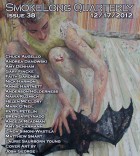What was the inspiration for this story?
Before I started this story I was thinking a lot about the way children interpret the world around them and how their outlook often differs greatly from an adult’s point of view. They can invest such creative thought into commonplace things, like how a stick, when picked up, instantly becomes a sword, or an overgrown lawn becomes a miniature jungle. Where we just see another chore—something that needs mowing. And their understanding of danger is different too: an odd shadow in their closet can frighten them, but a close call on the interstate doesn’t.
One of the things that drew me to “Dark Times” is that I felt I came away with a strong sense of the narrator’s world, but I know that there are often details authors know about their stories that aren’t necessarily shared in the text. What do you know about your narrator’s life that readers may not know?
An earlier draft focused more on the character of the father, but ultimately it didn’t seem like it was his story. So I reluctantly reduced him to a much more two-dimensional figure. Which is how I sometimes think children see adults—as placeholders in their own personal fable.
The pacing throughout the story is excellent. I love how it begins with a description of a peaceful farm and the tone becomes increasingly ominous. Was that intentional? If so, how did you approach the writing process to make that work?
Thank you, yes. I wanted to convey a sort of idyllic setting early in the story, a feeling that not much changes or is questioned in this place. Which I found can be challenging in such a constrained format. There’s not a lot of room to spin yarn. By postponing any sort of action until late in the story I try to highlight that eventual moment when the innocuous or mysterious becomes threatening.
You’ve described your writing process as more instinctive-based. How did that manifest itself for “Dark Times”?
Rather than meticulously plotting and outlining ahead of time, I usually start a story with nothing more than a first line or some small kernel of an idea. Which is probably why I have so many half finished and abandoned stories in my desk drawer. For “Dark Times,” I had only a rough idea of where it would lead when I started writing. Luckily, it seemed to pull itself together in the end.
At the end of the story, it’s not clear if the father is being paranoid or if the clouds do pose some kind of danger. Is there an answer to which it is? If so, does that answer make a difference in how the story should be interpreted?
There are all kinds of dangers in the world, some we can protect our children from, and others we can’t. I’m not sure which group precipitation belongs in.
How did you decide to write “Dark Times” as flash fiction?
I write poetry mostly, but lately I’ve been playing around with short fiction—it’s an incredibly versatile form and a lot of fun to write. This idea didn’t seem like it would work in any other format.
What’s next for you as a writer?
I belong to a small writing group and our penalties for not producing something for the weekly meeting are very strict, so I guess I’ll keep plugging away.



 The core workshop of SmokeLong Fitness is all in writing, so you can take part from anywhere at anytime. We are excited about creating a supportive, consistent and structured environment for flash writers to work on their craft in a community. We are thrilled and proud to say that our workshop participants have won, placed, or been listed in every major flash competition. Community works.
The core workshop of SmokeLong Fitness is all in writing, so you can take part from anywhere at anytime. We are excited about creating a supportive, consistent and structured environment for flash writers to work on their craft in a community. We are thrilled and proud to say that our workshop participants have won, placed, or been listed in every major flash competition. Community works.